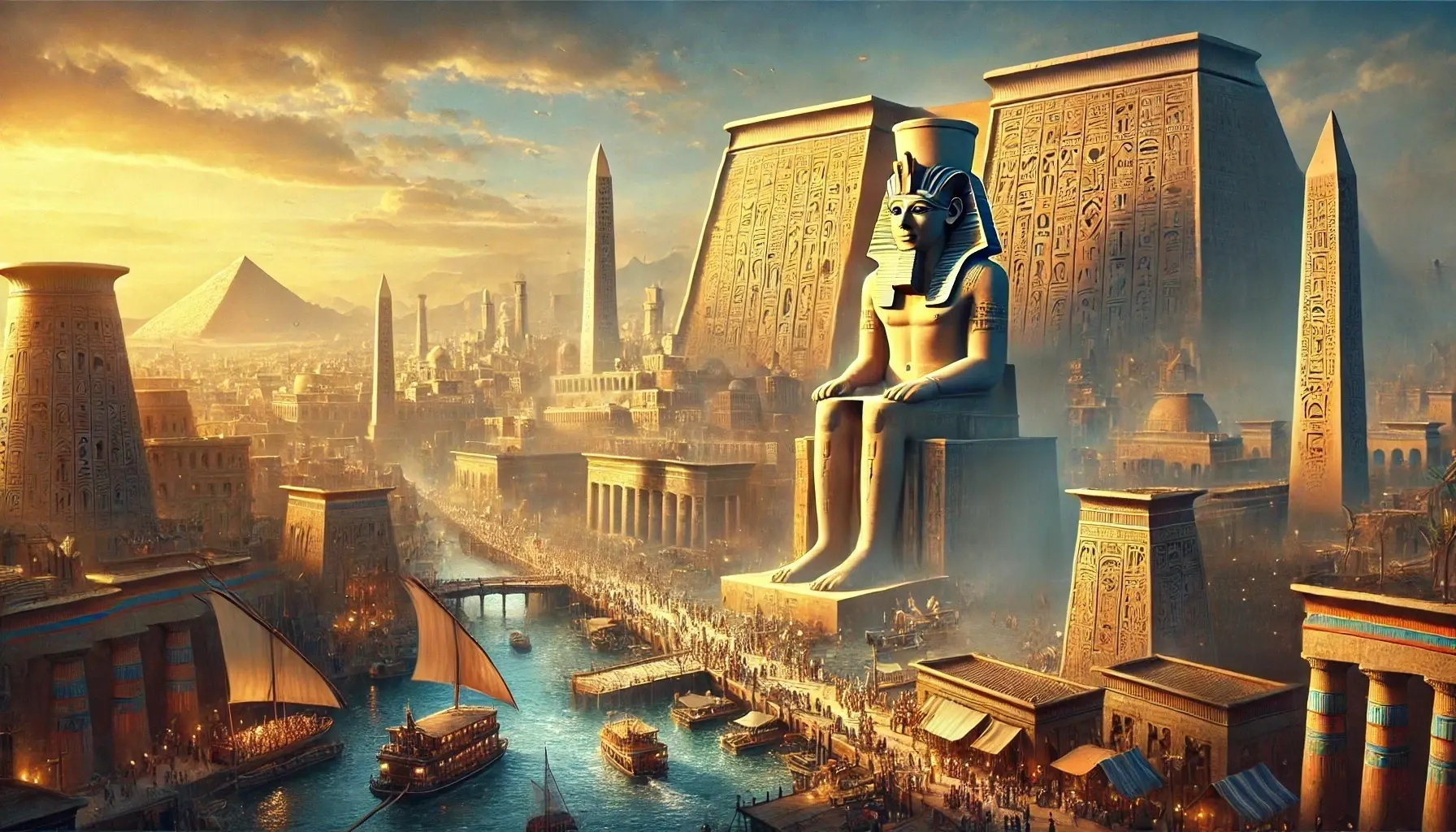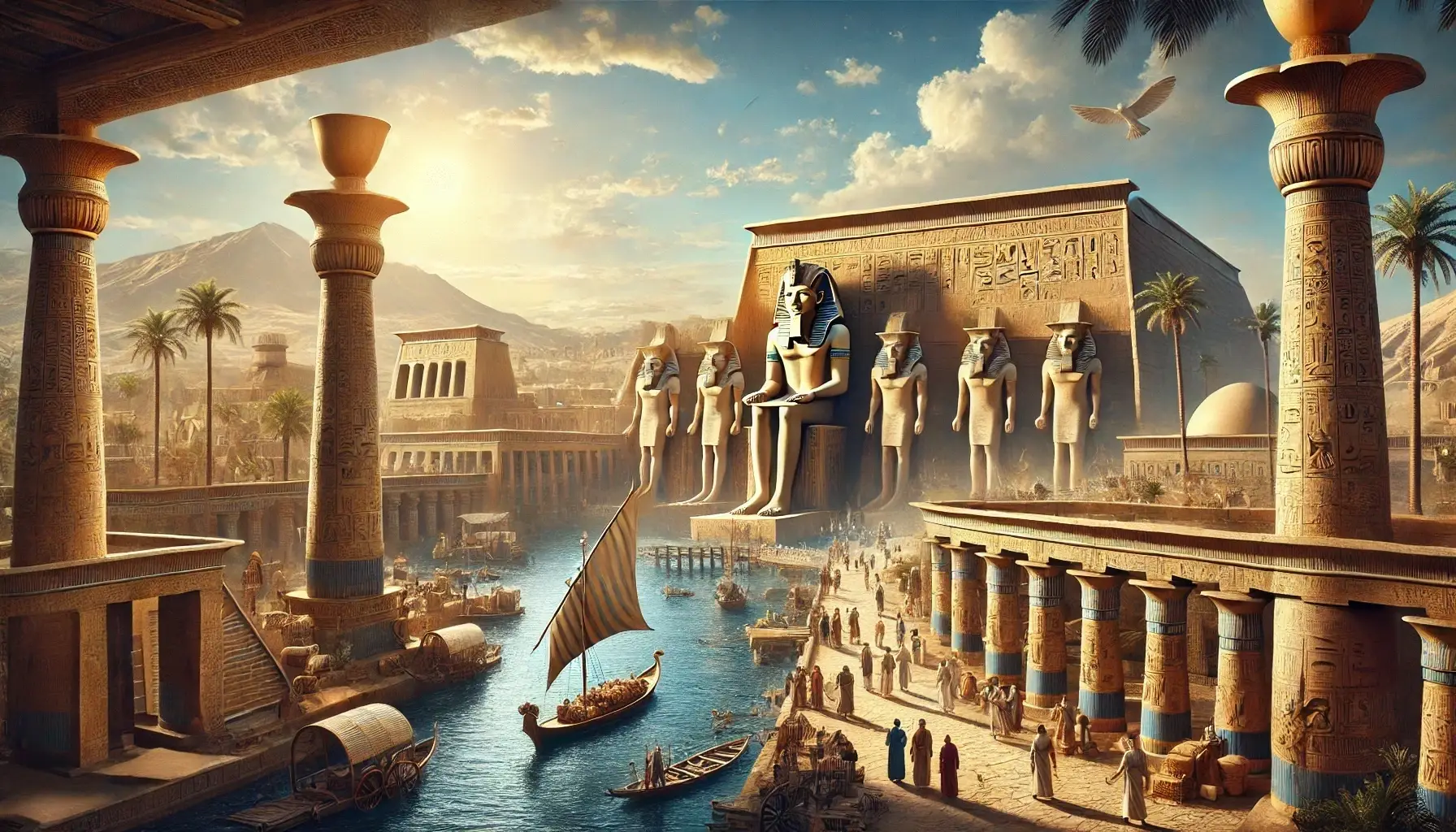The Vanished Metropolis of Ramesses the Great
It was a city of grand avenues, colossal temples, and a military force unrivaled in its time. Pi-Ramesses, the jewel of the Nile, stood as a testament to the might of Pharaoh Ramesses II, a ruler whose ambitions reshaped the ancient world. But today, the city exists only in ruins, its very location lost to time until recent archaeological revelations unearthed its secrets. Its rediscovery offers us a rare glimpse into the grandeur of the New Kingdom, when Egypt stood at the height of its power and influence.
The Rise of Pi-Ramesses
A Pharaoh’s Vision
In the 13th century BCE, Ramesses II sought to build a city that would surpass all others in splendor and strategic might. He chose the eastern Delta, where the Nile’s waters nourished fertile plains, and where an older city—Avaris, the former Hyksos capital—had already established a foundation for expansion.
Pi-Ramesses was born, named after the pharaoh himself: “House of Ramesses, Beloved of Amun, Great of Victories.” More than just a name, it was a statement of power, a bold declaration to Egypt and its enemies that a new era had begun. Here, Ramesses II consolidated his empire, forging alliances and preparing for military campaigns that would make his name legendary.
Engineering Marvels of the Ancient World
The city sprawled across nearly 10 square miles, an unprecedented scale for its time. Archaeological evidence suggests it was home to around 300,000 people, making it one of the largest cities of the Late Bronze Age. Its streets were lined with palaces, storerooms, and administrative buildings, while massive temple complexes honored Amun, Ra, and Set, the latter of whom Ramesses II particularly favored.
Bronze workshops, chariot factories, and naval docks ensured Egypt’s dominance in warfare, producing the formidable war machines that would confront the Hittites at Kadesh. With its direct access to the Mediterranean, Pi-Ramesses was not just a political capital but a bustling trade hub, linking Egypt to the wider world of the Levant, Anatolia, and beyond. Artisans and laborers crafted exquisite goods, many of which were sent to foreign lands as tributes and trade items, cementing Egypt’s economic strength.
The Glory Days of Pi-Ramesses
Heart of an Empire
For over a century, Pi-Ramesses stood as the nerve center of Egypt’s power. Here, treaties were signed, tributes were received, and wars were planned. It was a city of diplomacy as much as conquest, with emissaries from far-flung lands marveling at its towering obelisks and vast courtyards.
The Royal Residence and Temples
The pharaoh’s palace, gleaming with imported cedar and inlaid with gold, was a fortress of luxury. Murals depicted Ramesses’ triumphs, none more famous than his chariot charge at Kadesh, a battle immortalized in reliefs across Egypt.
The temples of Pi-Ramesses were among the most magnificent in the empire. The House of Set, adorned with colossal statues of the warrior god, rivaled even the temples of Karnak in grandeur. Priests conducted elaborate rituals here, ensuring divine favor for Egypt’s most powerful ruler.
The Role of Pi-Ramesses in Egypt’s Military Might
Pi-Ramesses was more than a ceremonial capital; it was the logistical heart of Egypt’s military machine. Chariot production reached an unprecedented scale, with thousands of these deadly vehicles rolling out of the city’s workshops. Bronze weaponry, arrows, and shields were forged to equip the vast army that would accompany Ramesses on his campaigns. The city’s strategic location allowed rapid mobilization of troops to counter threats from the east, particularly the growing power of the Hittites.
The Mystery of Its Disappearance
The Shifting Nile
The glory of Pi-Ramesses, however, was tied to the Nile, and the river is as fickle as it is bountiful. Over centuries, its branches shifted, cutting the city off from its lifeblood. Without access to the waterways that had once made it thrive, the metropolis began to wither.
By the reign of Pharaoh Shoshenq I (c. 943 BCE), Pi-Ramesses had already lost much of its former importance. The capital was moved to Tanis, and the city’s stones were repurposed to build the new seat of power. The great city of Ramesses the Great faded into memory, buried beneath the sands.
The Biblical Connection
Pi-Ramesses appears in biblical tradition as the city from which the Israelites are said to have departed during the Exodus. While historical evidence remains inconclusive, its mention in Exodus 1:11 as a site of forced labor suggests it held significance in the cultural memory of ancient peoples long after its decline.
The Decline and Scavenging of Pi-Ramesses
Once abandoned, Pi-Ramesses became a quarry for later Egyptian rulers. The monumental statues and temple stones were transported to Tanis, reassembled in new configurations to create the illusion of an enduring capital. What remained was slowly buried under layers of sediment, its memory surviving only in fragmented inscriptions and echoes in ancient texts.
Rediscovering Pi-Ramesses
A Case of Mistaken Identity
For centuries, scholars believed Tanis, with its massive ruins, was Pi-Ramesses. However, 20th-century excavations revealed a different story. The artifacts, inscriptions, and the telltale signs of river shifts pointed to a site near modern Qantir, about 30 km away. Here, archaeologists found remnants of the mighty city—shattered statues of Ramesses, fragments of chariot workshops, and the skeletal foundations of temples once revered by an empire.
A Legacy Unearthed
Today, Pi-Ramesses remains an active archaeological site, with ongoing digs revealing more of its past. Its rediscovery reshaped our understanding of Egypt’s New Kingdom, illustrating how even the grandest cities can vanish, their histories left to be pieced together from scattered relics.
Modern Insights and Continuing Excavations
Archaeologists continue to uncover new layers of Pi-Ramesses, using ground-penetrating radar to map out its former streets and districts. Artifacts reveal more details about daily life, from tools and pottery to inscriptions detailing the city’s role in diplomacy and warfare. Each discovery adds another piece to the puzzle, offering deeper insight into how this once-thriving metropolis functioned at the height of Egypt’s imperial power.
Conclusion: The Echo of a Lost Capital
Pi-Ramesses was more than a city; it was a declaration of supremacy, a monument to the vision of one of history’s greatest rulers. Though its walls have crumbled, its spirit endures in the temples and tombs that still bear the name of Ramesses the Great. From the sands of Egypt to the scrolls of history, the story of Pi-Ramesses reminds us that even the mightiest civilizations are at the mercy of time and tide.
As archaeologists continue their work, the city’s voice grows louder, whispering stories of ambition, conquest, and eventual decline. It stands as a reminder of the impermanence of human achievement, yet also of the lasting legacy left by those who dared to dream of greatness.



